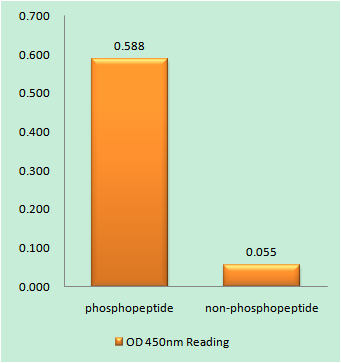产品名称
KCNQ2/3/4/5 (phospho Thr217/246/223/251) Rabbit Polyclonal Antibody
别名
KCNQ2; Potassium voltage-gated channel subfamily KQT member 2; KQT-like 2; Neuroblastoma-specific potassium channel subunit alpha KvLQT2; Voltage-gated potassium channel subunit Kv7.2; KCNQ3; Potassium voltage-gated channel subfamily KQT me
蛋白名称
Potassium voltage-gated channel subfamily KQT member 2
存储缓冲液
Liquid in PBS containing 50% glycerol, 0.5% BSA and 0.02% New type preservative N.
Human Gene ID
3785/3786/9132/56479
Human Gene Link
http://www.ncbi.nlm.nih.gov/sites/entrez?db=gene&term=3785
Human Swissprot No.
O43526/O43525/P56696/Q9NR82
Human Swissprot Link
http://www.uniprot.org/uniprotkb/O43526/entry
Mouse Gene ID
16536/110862/60613/226922
Mouse Gene Link
http://www.ncbi.nlm.nih.gov/sites/entrez?db=gene&term=16536
Rat Gene Link
http://www.ncbi.nlm.nih.gov/sites/entrez?db=gene&term=170848
Rat Swissprot No.
O88943/O88944/Q9JK96
Rat Swissprot Link
http://www.uniprot.org/uniprot/O88943
免疫原
The antiserum was produced against synthesized peptide derived from human Kv7.3/KCNQ3 around the phosphorylation site of Thr246. AA range:191-240
特异性
Phospho-KCNQ2/3/4/5 (T217/246/223/251) Polyclonal Antibody detects endogenous levels of KCNQ2/3/4/5 protein only when phosphorylated at T217/246/223/251.
稀释度
WB 1:500-2000 IHC 1:100 - 1:300. ELISA: 1:20000. IF 1:50-200
宿主
Polyclonal, Rabbit,IgG
背景介绍
The M channel is a slowly activating and deactivating potassium channel that plays a critical role in the regulation of neuronal excitability. The M channel is formed by the association of the protein encoded by this gene and a related protein encoded by the KCNQ3 gene, both integral membrane proteins. M channel currents are inhibited by M1 muscarinic acetylcholine receptors and activated by retigabine, a novel anti-convulsant drug. Defects in this gene are a cause of benign familial neonatal convulsions type 1 (BFNC), also known as epilepsy, benign neonatal type 1 (EBN1). At least five transcript variants encoding five different isoforms have been found for this gene. [provided by RefSeq, Jul 2008],
组织表达
In adult and fetal brain. Highly expressed in areas containing neuronal cell bodies, low in spinal cord and corpus callosum. Isoform 2 is preferentially expressed in differentiated neurons. Isoform 6 is prominent in fetal brain, undifferentiated neuroblastoma cells and brain tumors.
细胞定位
Cell membrane ; Multi-pass membrane protein .
功能
alternative products:Additional isoforms seem to exist,disease:Defects in KCNQ2 are the cause of benign neonatal epilepsy type 1 (EBN1) [MIM:121200]. Benign neonatal epilepsy is characterized by clusters of seizures occurring in the first days of life. Most patients have spontaneous remission by 12 months of age and show normal psychomotor development. The disorder is distinguished from benign familial infantile seizures by an earlier age at onset.,disease:Defects in KCNQ2 are the cause of benign neonatal epilepsy with myokymia (EBNMK) [MIM:606437]. EBNMK is a syndrome characterized by benign neonatal convulsions followed later in life by myokymia.,disease:Defects in KCNQ2 are the cause of myokymia isolated type 2 (MK2) [MIM:606437]. Myokymia is a condition characterized by spontaneous involuntary contraction of muscle fiber groups that can be observed as vermiform movement of the overlying skin. Electromyography typically shows continuous motor unit activity with spontaneous oligo- and multiplet-discharges of high intraburst frequency (myokymic discharges). Isolated spontaneous muscle twitches occur in many persons and have no grave significance.,domain:The segment S4 is probably the voltage-sensor and is characterized by a series of positively charged amino acids at every third position.,function:Probably important in the regulation of neuronal excitability. Associates with KCNQ3 to form a potassium channel with essentially identical properties to the channel underlying the native M-current, a slowly activating and deactivating potassium conductance which plays a critical role in determining the subthreshold electrical excitability of neurons as well as the responsiveness to synaptic inputs. KCNQ2/KCNQ3 current is blocked by linopirdine and XE991, and activated by the anticonvulsant retigabine. Muscarinic agonist oxotremorine-M strongly suppress KCNQ2/KCNQ3 current in cells in which cloned KCNQ2/KCNQ3 channels were coexpressed with M1 muscarinic receptors.,miscellaneous:Inclusion of isoform 6 in heteromultimers results in attenuation of potassium current. Prominent expression of isoform 6 in the developing brain may alter firing repertoires of immature neurons excitability to provide cues for proliferation rather than differentiation.,miscellaneous:Mutagenesis experiments were carried out in Xenopus oocytes by coexpression of either KCNQ2(mut) and KCNQ3 at the ratio of 1:1, or of KCNQ2(mut), KCNQ2(wt) and KCNQ3 at the ratio of 1:1:2, to mimic the situation in a heterozygous patient with BFNC1 disease.,PTM:In Xenopus oocytes KCNQ2/KCNQ3 heteromeric current can be increased by intracellular cyclic AMP, an effect that depends on phosphorylation of Ser-52 in the N-terminus region.,similarity:Belongs to the potassium channel family. KQT subfamily.,subunit:Heteromultimer with KCNQ3. May associate with KCNE2.,tissue specificity:In adult and fetal brain. Highly expressed in areas containing neuronal cell bodies, low in spinal chord and corpus callosum. Isoform 2 is preferentially expressed in differentiated neurons, whereas isoform 6 is prominent in fetal brain, undifferentiated neuroblastoma cells, and brain tumors.,
纯化
The antibody was affinity-purified from rabbit antiserum by affinity-chromatography using epitope-specific immunogen.


